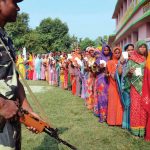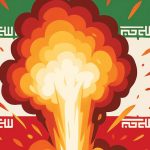What should be the Role of the Chief of Defence Staff?
Welcome the Super General
 Maroof Raza
Maroof Raza
 Maroof Raza
|
23 Aug, 2019
Maroof Raza
|
23 Aug, 2019
/wp-content/uploads/2019/08/Corrrected.jpg)
(L-R) Air Force Chief Birender Singh Dhanoa, Navy Chief Karambir Singh and Army Chief Bipin Rawat (Illustration: Saurabh Singh)
FEW PEOPLE, OUTSIDE those informed about India’s higher defence organisation, know that the defence of India—as per the Government of India (Transaction of Business ) Rules, 1961—is the responsibility of civilians, the defence minister (a political appointee) and the defence secretary (a bureaucrat), and not the service chiefs! The chiefs of India’s armed forces are responsible through the defence ministry for the command, training, administration and preparation for a war of their respective services. No wonder, it has led many commentators to say that India has the most absurd civil-military equation for a country with such an impressive military tradition and with all the military challenges it continues to face.
These rules, it appears, were formulated by copying the British system, which has influenced the structures of India’s Ministry of Defence (MoD) and those of its armed forces. However, in the British system, the defence secretary is a politician and a minister in their prime minister’s cabinet, whereas, in India, the defence secretary is a civil servant. Even in the American system, the defence secretary is appointed by the president, who may be neither a politician nor a bureaucrat but has cabinet rank. But in India, a secretary is a high-ranking bureaucrat and not a politician.
Therefore, India’s armed forces have been insisting on a military officer as the chief of defence staff (CDS) since the armed forces have a number of professional requirements that need domain expertise, which a generalist bureaucrat doesn’t have. However, as a legacy of the Jawaharlal Nehru and Krishna Menon era, the bureaucracy is all over the Indian Ministry of Defence and all-powerful. But military people say that they are often neither held accountable—as the defence secretary, after the 1962 military debacle, was only posted out to another ministry while the defence minister and many senior generals resigned—nor are they sufficiently sympathetic to the needs of serving and retired personnel of India’s armed forces. Thus, the announcement that India would now have a CDS has brought some relief in military circles, though there is much to be done before a CDS adequately addresses our security concerns.
The idea of a CDS was apparently first brought up after the 1971 war, when it was suggested that Field Marshal Sam Manekshaw should be made the first CDS. Not only did Manekshaw soon fall out of favour with then Prime Minister Indira Gandhi but his candidature too was apparently vetoed by then Air Chief Marshal PC Lal (with whom Manekshaw was not quite on talking terms, at least during the 1971 war) and then Defence Secretary KB Lall, as Manekshaw was known to bulldoze his way past the bureaucracy.
The matter thereafter lay in limbo for another four decades, as the bureaucracy was quite happy to see that the three service chiefs were not on the same page at least on this issue. Interestingly, the strongest opposition to the idea of a CDS still comes from the Indian Air Force (IAF) and the IAS lobbies. Even during the Kargil conflict, it was said that the then Army Chief, General Ved Prakash Malik, and then Air Chief Marshal Anil Tipnis had major differences on the use of airpower and helicopter gunships against Pakistani bunkers. Such differences and delays cost lives of soldiers on the ground. However, it was eventually resolved and the IAF became a force multiplier. But following the Kargil conflict, the Kargil Review Committee (KRC) report had recommended that a CDS was essential for the demands of modern warfare—which require inter-services cooperation—to achieve our political goals with the limited resources of our armed forces. And thereafter, following the KRC’s recommendations, a Group of Ministers supported the idea of CDS and so did the Naresh Chandra committee on defence reforms. As did a study by a team headed by Lieutenant General DB Shekatkar in 2016—since India’s armed forces have traditionally operated in silos, with each service having its own doctrine, its own equipment purchases, and its own professional traditions and culture.
This has always led to heartburn and wrangling over who would get how much of the limited funds left for the purchase of critical military equipment to fight wars. It has to be done with what remains after the basic needs of the services, such as salaries and infrastructure upgrades, are met, with increasingly dwindling defence budgets. The CDS, once fully operational, could help the Government meet the requirements of the armed forces—more so, as it is known that the advice given by the defence secretary to the Cabinet on our state of military preparedness has sometimes been questionable. For instance, during the Kargil conflict, the then Defence Secretary had told the Cabinet that while General Malik was publicly stating that the Army was short of basic weapons to fight Pakistani intruders, there were enough rifles available in our ordnance depots. A quick check by Army headquarters revealed that indeed there were rifles, but these were of World War II vintage and it would have been suicidal to send our troops into battle with vintage .303s. And even now, with a few exceptions, a generalist bureaucrat without domain expertise, but responsible for the defence of India, would often be hard put to differentiate between an armoured car and armoured vehicle.
As the CDS would be the single point of military advice for the Prime Minister and his cabinet, the role must not threaten the civilian bureaucracy in the MoD nor the service chiefs and their fiefdoms
The question now is: What should be the role of the CDS? We’ve had a Headquarters of Integrated Defence Staff (IDS) in the MoD for 15 years now which has been waiting for a CDS to help it fulfil its role. To begin with, it must be ensured that the CDS is a military man, from any of the three services but picked for his suitability for the job, ideally after his having been a service chief and not purely on the basis of seniority, as has been the case till now with the chairman of the chiefs of staff, which is held by the seniormost service chief. And as the CDS would be the single point of military advice for the prime minister and his Cabinet, the role must not threaten the civilian bureaucracy in the MoD nor the service chiefs and their fiefdoms. Instead, the CDS could be given a proactive role in streamlining our defence and military acquisition processes and facilitating the inter-services sharing of equipment and resources.
Equally, the CDS could advise the Government on how India’s armed forces must prepare for the future challenges of threats in the cyber and space domains as also for the better sharing of intelligence inputs. And, of course, there is a need to synergise the warfighting doctrines of our three services which are currently tailored to meet their own specific requirements, instead of an ‘air-land’ or ‘air-sea’ operation as well as out-of-area operations beyond India’s borders. For this, the CDS must be above the service chiefs. Also, if we go for theatre commands, the CDS must be their overall coordinator.
However, the establishment of theatre commands, which I’m told is also opposed by the IAF, will take time. While our armed forces have been greatly influenced by the British tradition and though they often quote the American model now—with theatre commands the world over—perhaps, the Chinese model is a better option for India. In 2016, Chinese President Xi Jinping appointed their first chief of joint staff and divided China’s armed forces into theatre commands for managing their military operational needs. Thus, China’s Western Command in Chengdu is now focused on India and parts of Central Asia with adequate land and air resources to fight a war in the high Himalayas. India, on the other hand, has a fragmented approach to dealing with the Chinese, with multiple Commands of the Army (in Jammu &Kashmir, Lucknow and Kolkata), the Air Force (in Shillong and in Jammu & Kashmir) and the Navy (in Visakhapatnam), all prepared to battle the Chinese threat. In fact, India has 17 military commands in all and each of them has operational roles that overlap with those of sister services, leaving a massive logistics tail.
Thus, what India needs are theatre commands that cover all our threats and use our limited resources to the optimum. This author had proposed the idea of theatre commands about 25 years ago and these could be as follows. A theatre command to address the threat from China that would start from India’s Northeast on the India-Myanmar border and go along the Sino-Indian boundary to the Line of Actual Control in Aksai Chin. The other would focus on Pakistan, starting from the Siachen Glacier and proceeding along the Line of Control and Indo-Pak border right up to the Rann of Kutch. Both should be headed, always, by Army officers with adequate components of the Air Force in particular and some elements of the Navy, since their primary threats would be on land. And then, a peninsular command which would run from the coast of Gujarat right along the Indian coastline up to West Bengal and Bangladesh. This command should be headed by a naval officer since its primary role would be to guard against maritime threats and manage out-of-area operations. This theatre would have the necessary Army and air resources to meet all its contingencies. Finally, an air and missile forces command that could be used in addition to the other commands. Its role would be to provide air and missile firepower as force multipliers to any operations India’s armed forces might have to undertake along our land or sea borders. The CDS should be the link between the Cabinet Committee on Security (CCS) and the defence minister to coordinate their operational engagements without interfering with their roles.
Although the decision to use nuclear weapons will continue to rest with the Prime Minister and the CCS via the Defence Minister, the CDS could manage their deployment along with the service chiefs, theatre commanders and the scientific community
And then there is the issue of nuclear weapons. Although the decision to use them will continue to rest with the prime minister and the CCS via the defence minister, the CDS could manage their deployment along with the service chiefs, theatre commanders and the scientific community. Here, the CDS could play a very important role in coordinating between civilian leadership and military headquarters—and he would need to do so in double-quick time. For this reason itself, the CDS must be given the necessary authority to ensure that we are not fumbling when faced with threats from an increasingly aggressive Pakistan or China. To that extent, India could closely look at the US’ Goldwater-Nichols Act of 1986 that gives their chairman of joint chiefs of staff direct access to the president, the supreme military commander of the US—in India’s case, this would have to be modified for the CDS to have direct access to the defence minister—but without his interfering with the operational roles of US theatre commanders all over the world. But unlike the US, the CDS in India would need to coordinate with theatre commanders and service headquarters since there could be conflicts of professional opinion among service chiefs and theatre commanders.
In all of this, the bureaucracy in the MoD should retain its own relevance while the CDS with its own headquarters would work to fill the gap of professional knowledge that the bureaucracy suffers from since bureaucrats are not career military officers but civil servants who, at least at the decision-making levels (joint secretary upwards), shift from one ministry to another and are thus familiar with the Government’s rules and regulations. One major shortcoming of our absurd system has been the confusion over the need for critical military equipment. This is something the armed forces are best placed to handle. To that extent, there is a need for military officers being positioned alongside bureaucrats in the MoD.
And finally, the fear, promoted sometimes by the bureaucracy and intelligence agencies, that the ‘super general’ (a CDS) once appointed could energise the armed forces into taking over the country is ridiculous, to say the least. Nothing can be further from the truth and it is an insult to the integrity of India’s armed forces that have remained steadfastly loyal to the Constitution and the elected Government. In fact, their professionalism and their apolitical conduct have been an example to others in the developing world.

/wp-content/uploads/2025/06/Cover-OpenMinds2025.jpg)












More Columns
Puri Marks Sixth Major Stampede of The Year Open
Under the sunlit skies, in the city of Copernicus Sabin Iqbal
EC uploads Bihar’s 2003 electoral roll to ease document submission Open